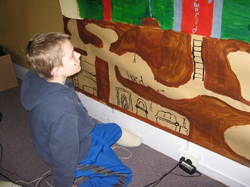 I am discovering the phrase “independent learner”, which is placed prominently in all of Deep Root Center's informational literature, elicits many emotions, meanings, and for that matter different responses for each individual who reads or hears it. For some it is excitement or relief, “wow, I get to choose anything in the whole wide world to learn about. Cool, I can't wait! I want to...” For others it brings on a feeling of pure panic or consternation, “Holy Cow, I have to decide what I want to learn? The world of options is way to big and overwhelming. Hold on, way to much responsibility, I can't do that. Please just tell me what to do.” I have encountered both extremes while implementing and explaining our philosophy and methods to kids and parents. I am learning how to negotiate the advisor/advisee path for these completely legitimate responses to our program. Some people are by nature very independent and self-sufficient. They hate it when someone or something tells them what to do or how to do it. They have their own plans and ideas and just want to get busy doing it. These are the folks who never (or very rarely) read instructions. They don't want to hear “you should do this… because someday you will need to know how to ...” They just want to learn by trial and error. “Get off my back already,” is usually the thought running through their heads. These are kids who are ready to get on with living life. For these youth, I will listen very carefully to their dreams and intentions. I want to know what they are most excited about. Then we can look at ways to implement those ideas and find the resources that will make it all happen. My role is to ask pertinent questions, help find people in the community who will be the most help to this student, and stand back and cheer. Other folks are more tentative and unsure. The variety of choices even within one subject area is way overwhelming. “I don't know what I like, I haven't discovered everything out there yet. I don't even know what the options are, for goodness sake.” These are kids who need to feel the safety and comfort of a narrow range of choices. So, we will create a schedule with specific time periods assigned to several subject areas. Within each of those time slots there will be a small variety of alternatives. During the scheduled writing time, the student can choose whether they would like a writing prompt, a poem starter or free time to write an original story. At research time, we can listen to a podcast or watch a video and choose how we want to respond to it, a discussion, a written presentation or a visual creation. This method feels safe, while allowing for decision making and freedom of choice. These youth need a bit more nurturing and support, but in many ways my role is the same. I am listening very carefully; I am still asking questions, and finding resources within the community. But, my favorite part is responding to anything they have produced, created or said, with, “wow, that's awesome” and watching the slow smile creep across their faces when they realize they can do anything they set their minds and hearts to.
0 Comments
Your comment will be posted after it is approved.
Leave a Reply. |
|
© 2024 Whole Learners, Inc. 501(c)3
Deep Root Center
48 Riverside Drive, Canton, NY 13617
315*323*1435/[email protected]
Deep Root Center
48 Riverside Drive, Canton, NY 13617
315*323*1435/[email protected]


